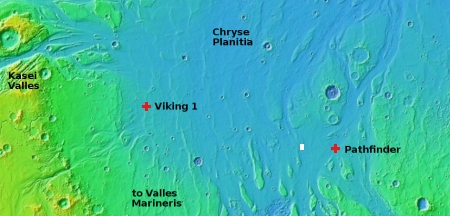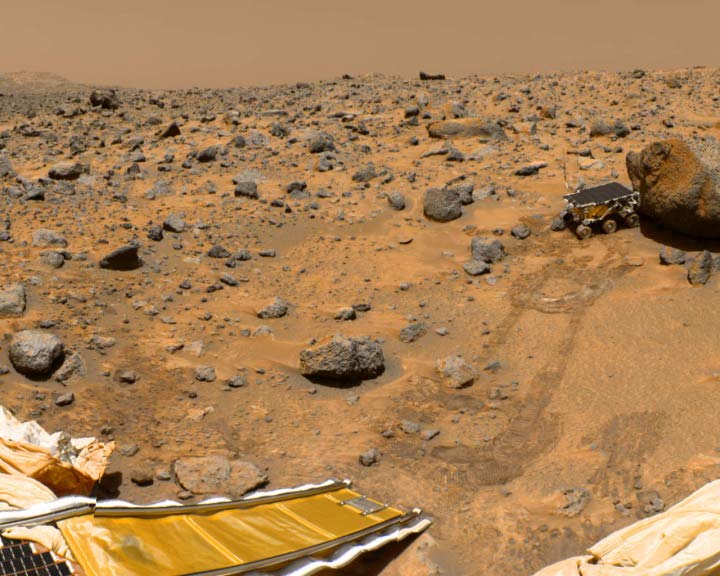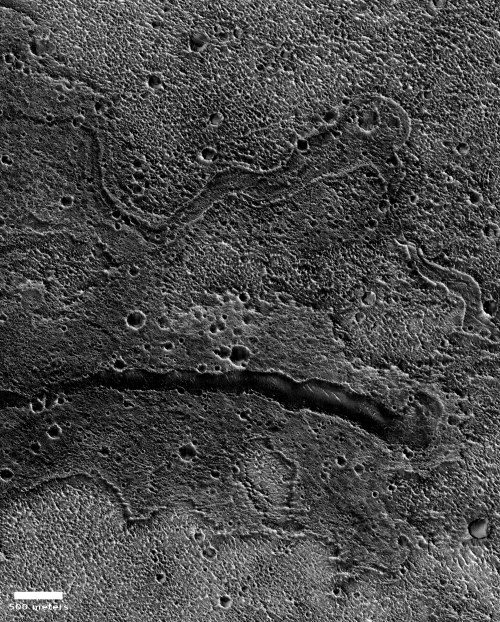“Flow-like” feature in the Martian lowlands
Cool image time! The photo to the right, rotated, cropped, reduced, and brightness-enhanced to post here, was taken on July 6, 2020 by the high resolution camera on Mars Reconnaissance Orbiter (MRO).
This is an uncaptioned image, labeled by the MRO science team as a “Flow-Like Feature in Chryse Planitia,” suggesting that they themselves are not exactly sure about what we are looking at. The latitude is 19 degrees north, which is a bit too far south for finding glacial features. Moreover, the craggy look of the ground here does not suggest an eroding glacier, but of eroding bedrock.
We could be looking at a volcanic feature, but this location is very far from Mars’ volcano regions. Nonetheless, another high resolution image, taken just to the west of this photo and given the exact same label, shows similar geology, and does strongly invoke a look of corroded lava flow.
The overview map below gives the context.

Chryse Planitia is the lowland northern plain that received the drainage down from the giant Martian volcanoes, coming from both Valles Marineris and Kasei Valles. It is also the place that two American landers put down, Viking 1 in 1976 and Pathfinder in 1997. In fact, this image, indicated by the white box, is only about 108 miles west of the Mars Pathfinder landing site where the rover Sojourner roved for almost three months. The photo below shows Sojourner up against a boulder, the image taken from Pathfinder. The ramp that the rover used to get to the surface can be seen on the bottom left.

The results from Pathfinder and Sojourner suggested the presence of melted ejecta from impacts, melt from volcanic processes, and sedimentary and rounded rocks suggesting water processes.
None of this of course clarifies the flow feature in the cool image above, as all these process could have created this feature. It only adds to the mystery.
On Christmas Eve 1968 three Americans became the first humans to visit another world. What they did to celebrate was unexpected and profound, and will be remembered throughout all human history. Genesis: the Story of Apollo 8, Robert Zimmerman's classic history of humanity's first journey to another world, tells that story, and it is now available as both an ebook and an audiobook, both with a foreword by Valerie Anders and a new introduction by Robert Zimmerman.
The print edition can be purchased at Amazon or from any other book seller. If you want an autographed copy the price is $60 for the hardback and $45 for the paperback, plus $8 shipping for each. Go here for purchasing details. The ebook is available everywhere for $5.99 (before discount) at amazon, or direct from my ebook publisher, ebookit. If you buy it from ebookit you don't support the big tech companies and the author gets a bigger cut much sooner.
The audiobook is also available at all these vendors, and is also free with a 30-day trial membership to Audible.
"Not simply about one mission, [Genesis] is also the history of America's quest for the moon... Zimmerman has done a masterful job of tying disparate events together into a solid account of one of America's greatest human triumphs."--San Antonio Express-News
Cool image time! The photo to the right, rotated, cropped, reduced, and brightness-enhanced to post here, was taken on July 6, 2020 by the high resolution camera on Mars Reconnaissance Orbiter (MRO).
This is an uncaptioned image, labeled by the MRO science team as a “Flow-Like Feature in Chryse Planitia,” suggesting that they themselves are not exactly sure about what we are looking at. The latitude is 19 degrees north, which is a bit too far south for finding glacial features. Moreover, the craggy look of the ground here does not suggest an eroding glacier, but of eroding bedrock.
We could be looking at a volcanic feature, but this location is very far from Mars’ volcano regions. Nonetheless, another high resolution image, taken just to the west of this photo and given the exact same label, shows similar geology, and does strongly invoke a look of corroded lava flow.
The overview map below gives the context.

Chryse Planitia is the lowland northern plain that received the drainage down from the giant Martian volcanoes, coming from both Valles Marineris and Kasei Valles. It is also the place that two American landers put down, Viking 1 in 1976 and Pathfinder in 1997. In fact, this image, indicated by the white box, is only about 108 miles west of the Mars Pathfinder landing site where the rover Sojourner roved for almost three months. The photo below shows Sojourner up against a boulder, the image taken from Pathfinder. The ramp that the rover used to get to the surface can be seen on the bottom left.

The results from Pathfinder and Sojourner suggested the presence of melted ejecta from impacts, melt from volcanic processes, and sedimentary and rounded rocks suggesting water processes.
None of this of course clarifies the flow feature in the cool image above, as all these process could have created this feature. It only adds to the mystery.
On Christmas Eve 1968 three Americans became the first humans to visit another world. What they did to celebrate was unexpected and profound, and will be remembered throughout all human history. Genesis: the Story of Apollo 8, Robert Zimmerman's classic history of humanity's first journey to another world, tells that story, and it is now available as both an ebook and an audiobook, both with a foreword by Valerie Anders and a new introduction by Robert Zimmerman.
The print edition can be purchased at Amazon or from any other book seller. If you want an autographed copy the price is $60 for the hardback and $45 for the paperback, plus $8 shipping for each. Go here for purchasing details. The ebook is available everywhere for $5.99 (before discount) at amazon, or direct from my ebook publisher, ebookit. If you buy it from ebookit you don't support the big tech companies and the author gets a bigger cut much sooner.
The audiobook is also available at all these vendors, and is also free with a 30-day trial membership to Audible.
"Not simply about one mission, [Genesis] is also the history of America's quest for the moon... Zimmerman has done a masterful job of tying disparate events together into a solid account of one of America's greatest human triumphs."--San Antonio Express-News



I don’t know why 19 degrees south would be too close to the equator. According to theory, Mars’ inclination varies wildly over the eons. Suppose, a billion years ago, the tilt was 70 degrees, and we could consider 19 degrees south to have near polar conditions. Just a thought.
Rod: I think you are new here. Do a search on Behind the Black for glaciers and Mars. You will learn a lot.
Start however here: The glaciers of Mars. At this moment, scientists have found glacial features in large numbers in the latitude bands from 30 to 60 degrees. Farther south the evidence of water ice peters out, though not in every place.
At 19 degrees it is unlikely this is glacial. Moreover, if you look at the many cool images that will come up in that search, you will begin to understand why this does not look like a glacier to me. The features aren’t the same as seen in the many other examples.
However, you are right about Mars’ inclination, or obliquity as the scientists have told me is the correct term. It changes a lot over eons, from 11 degrees to 60 degrees. Today it is about 25 degrees. Things would have been very different when that obliquity was different. Once again, read some of those other links for info on what is presently believed.